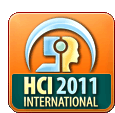T11: Assessing Usability Capability using ISO Standards
Half Day Tutotial
Nigel Bevan (short bio)
Professional Usability Services, United Kingdom
Objective
Participants will learn how the ISO 18529 model of human centered design can be used informally for process improvement, or for more formal assessments of usability maturity.
- They will be introduced to ISO 9241-210 standard for human centered design, and the list of essential human centered activities in ISO TR 18529.
- How ISO 18529 activities map onto typical user centered design methods.
- How to organize a process improvement workshop. How usability maturity can be assessed.
Content and Benefits
A commonly reported approach to usability process improvement is for an organization to start with usability testing as this has recognized value, even though the benefits are limited by the difficulty of making significant improvements late in the lifecycle. The perceived benefits of testing are then used to gradually justify activities earlier in the lifecycle.
The difficulty with this approach is that it usually only involves relatively junior management. When personnel change, or economies are being made in the organization the usability work can be vulnerable.
The tutorial will suggest a more effective approach to usability process improvement, by auditing the extent to which the good practice embodied in ISO TR 18529 is implemented in typical projects, and identifying areas for organizational improvement.
ISO TR 18529 "Human-centred lifecycle process descriptions" contains a detailed set of human centered activities derived from ISO 13407 that are potentially needed to implement human centered design in systems development.
Each ISO 18529 activity can be assessed as not done, partially done, or fully done and managed, as part of systems development. This can be carried out relatively informally in a process improvement workshop, or as part of a more formal process assessment of usability maturity (analogous to the software process assessment that can be carried out using the SEI CMM - Capability Maturity Model).
This information enables an organization to decide how much improvement is desirable in particular areas, or on an activity-by-activity basis.
Case studies will be presented, including a formal usability process assessment of an IT department, and of a simple one-day workshop that provided the basis for process improvement at an aerospace company.
The presenter will question volunteers from the audience to demonstrate how to assess the extent to which their organizations carry out the activities, and discuss strategies for process improvement.
A discussion group with resources to support the tutorial will be established so that participants can share experience of applying the principles.
Target Audience
Anyone who has some responsibility for user-centered design in their organization, or who would like to make a case for improving their organizational capability. Basic familiarity with the area of user-centered design is assumed, but no prior knowledge of ISO standards is needed.
The tutorial will be useful to:
- Usability and user centered design specialists who need to justify the use of user centered design methods in their organization.
- Project managers with responsibility for activities including use of user centered methods.
- Anyone who would like to understand the value of the ISO model of human centered design.
Relevant links
Reference material
Bio Sketch of Presenter:


